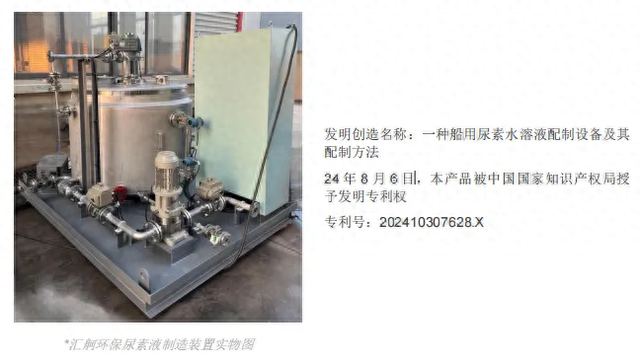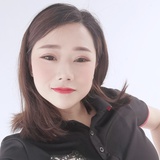
2024 年底,汇舸环保自主研发制造的船用尿素液制造装置,顺利交付位于日本今治的浅川船厂。设备整体性能指标达到国际领先水平,生产的尿素液产品,完全满足 ISO 18611-1:2014 船用氮氧化物还原剂的质量特性,即浓度为 40%的尿素液(AUS 40)。

据统计 2008 年,全球海运船舶的污染物排放量占 NOx 和 SOx 排放总量的 18%-30%和 9%。因此,国际海事组织(IMO)推出了可谓史上最严苛的 IMO Tier III 排放标准,其要求与 Tier II 标准相比,2 / 4符合 Tier III 标准的发动机的氮氧化物排放量须减少近 76%。而当前符合 IMO NOx Tier III 排放标准限值的现有技术包括:选择性催化还原 SCR (Selective Catalytic Reduction)系统、废气再循环装置 EGR(Exhaust Gas Recirculation)、替代燃料等。SCR 技术是降低 NOx 排放较为有效的途径之一, 可有效脱硝 70–90%以上。
SCR 技术是指在催化剂(广泛使用催化剂是 V2O5/TiO2)的作用下,利用还原剂(如 NH3、液氨、尿素)来“有选择性”地与烟气中的 NOx反应并生成无毒无污染的 N2 和 H2O。
因此采用 SCR 技术的船舶必须补充和储存尿素液。但是,尿素液的采购成本和运输成本高于颗粒尿素,而且尿素液的储存时间有限,制造商建议自生产之日起有效期通常为 6 到 18 个月(与储存温度有关)。
AUS40 尿素液可采购的港口有限,必须大量购买储存,而未使用的残留尿素液则很可能过期,长期储存后如果使用前成分测试结果不合格,必须进行废弃处理,或在 III 级限制区域外强制消费。另外,很多港口不回收 IBC 标准的尿素液包装容器,废弃成本很高。
目前装船使用中的尿素液制造装置,普遍存在尿素颗粒溶解不彻底,加料不方便,制造时溢出的气体污染舱室环境等问题。
针对上述问题,通过采纳结合各方的安装和操作建议,汇舸环保自主研发设计了 CGT 系列尿素液制造装置。用船舶造水机生产的纯水按配比加入定量的尿素颗粒后,在搅拌罐内充分搅拌,同时对搅拌罐夹套内的加热用淡水进行加热,加快和确保尿素颗粒彻底溶解。同时罐体增加排气口,按需引管到敞开甲板,使得尿素液制造场所的环境可视为零污染,确保了尿素液 AUS4O 生产的安全性和高质量。
目前,各类规格型号的尿素液制造装置在海内外市场,特别是日本、韩国,获得高度认可,并取得了良好的销售业绩。
在船用 AUS40 尿素液制造装置基础上,汇舸环保也已成功研发了陆用 AUS32 尿素液制造装置,综合了纯水制造和尿素液定量加注装置的形式,满足陆岸上重载卡车的尿素液需求,以城市用水输入,AUS40/AUS32 输出的模式,满足市场需求。
Name of invention:
A type of marine urea solution preparation equipment and its preparation method.
The product was authorized the invention patent by the State Intellectual Property Office of the People’s Republic of China on 6th Aug, 24.
Patent number: 202410307628.X
At the end of 24, Marine Urea solution production plant were successfully delivered to Asakawa Shipyard in Imabari, Japan. it was independently developed and manufactured by ContiOcean . The performance of the equipment has reached the international leading level, and the production of urea solution meet the quality characteristics of ISO 18611-1:2014--Marine NOX reduction agent AUS40- aqueous urea solution at 40 % concentration (AUS 40).
According to statistics, in 2008, the pollutant emissions of global maritime vessels accounted for 18%-30% and 9% of the total NOx and SOx emissions. As a result, the International Maritime Organization (IMO) has introduced the most stringent IMO Tier III emissions standards in history, requiring a nearly 76% reduction in NOx emissions from Tier III-compliant engines compared to Tier II standards. Existing technologies that meet IMO NOx Tier III emission limits include: Selective Catalytic Reduction (SCR) system, Exhaust Gas Recirculation (EGR), alternative fuels, etc. SCR technology is one of the more effective methods to reduce NOx emissions, It can effectively remove more than 70-90% of the nitrate.
SCR technology refers to the use of reducing agents (such as NH3, liquid ammonia, urea) to "selectively" react with NOx in flue gas and generate non-toxic and pollution-free N2 and H2O under the action of a catalyst (widely used catalyst is V2O5/TiO2).
Therefore, ships adopt SCR technology must replenish and storage urea solution. But the procurement cost and transportation cost of urea solution are higher than that of urea granules, and the storage time of urea solution is limited, and the manufacturer recommends an expiration date from the date of production: Usually 6 to 18 months (depending on storage temperature).
AUS40 urea solution can be purchased from a limited number of ports, so must be purchased in bulk for storage, but unused residual urea solution is likely to expire, and If the composition test results fail before use after long-term storage, it must be disposed of or forced consumption outside a Level III restricted area. In addition, many ports do not recycle IBC standard urea solution packaging containers, and the cost of abandonment is high.
At present, the urea solution production plant used on ships generally has problems, such as incomplete dissolution of urea granules, feeding trouble, and engine room environmental pollution of by gas overflow during manufacturing.
In view of the above problems, ContiOcean independently developed and designed the CGT series urea solution production plant, by adopting the installation and operation suggestions of various parties. Quantitative urea granules are added to the pure water produced by the ship's water generator according to the ratio, and are fully stirred in the mixing tank, while jacketed heating is used to speed up and ensure the complete dissolution of urea granules. At the same time, an exhaust port is added to the tank, and the pipe is led to the open deck as needed, so that the environment of the urea solution production plant site can be regarded as zero pollution. Ensure the safety and high quality of AUS4O production of urea solution.
At present, urea solution production plant of various specifications and models have been highly recognized in domestic and overseas markets, especially in Japan and South Korea, and have achieved good sales performance.
On the basis of the Marine AUS40 urea solution production plant, Contiocean has also successfully developed AUS32 for vehicles, which integrates the form of pure water generator and urea solution quantitative filling device, the urban water input, AUS40/AUS32 output mode, to meet the market demand.
